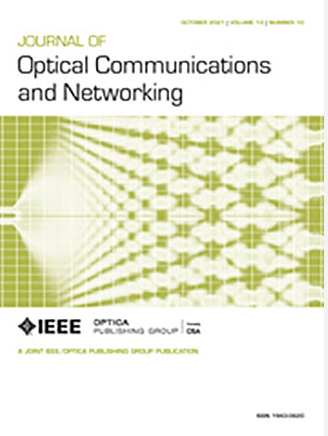SDN-controlled open RAN X-haul with point-to-multipoint transceivers on a horseshoe network
IF 4.3
2区 计算机科学
Q1 COMPUTER SCIENCE, HARDWARE & ARCHITECTURE
引用次数: 0
Abstract
Open RAN (O-RAN) is an architectural framework for 5G and beyond that enables an open, interoperable RAN infrastructure, with the centralized unit handling higher-layer functions and mobility management, and the distributed unit (DU) managing real-time, lower-layer operations near the radio units. Due to its inherently hub-and-spoke architecture, O-RAN is well suited for integrating point-to-multipoint (P2MP) coherent transceivers, enabled by digital subcarrier multiplexing (DSCM), to improve efficiency and reduce costs. On the other hand, the shift toward network disaggregation, driven by software-defined networking, promotes interoperability and automation. However, the control of commercially available P2MP transceivers remains proprietary, highlighting the need for open and standardized management frameworks. Therefore, we first propose an augmentation of the OpenConfig YANG data model for terminal devices to control DSCM and coherent P2MP transceivers. An experimental demonstration is shown in an integrated data and control plane testbed. Then, the first experimental implementation of Open RAN X-haul using P2MP transceivers on horseshoe optical networks is reported. 5G DU and P2MP leaf transceivers are dynamically activated according to cell traffic conditions to optimize energy efficiency.sdn控制的开放式RAN X-haul在马蹄形网络上具有点对多点收发器
开放RAN (O-RAN)是5G及以后的架构框架,可实现开放、可互操作的RAN基础设施,其中集中式单元处理高层功能和移动性管理,分布式单元(DU)管理无线电单元附近的实时、低层操作。由于其固有的轮辐结构,O-RAN非常适合集成由数字子载波复用(DSCM)实现的点对多点(P2MP)相干收发器,以提高效率并降低成本。另一方面,由软件定义网络驱动的向网络分解的转变促进了互操作性和自动化。然而,对商用P2MP收发器的控制仍然是专有的,这突出了对开放和标准化管理框架的需求。因此,我们首先提出对终端设备的OpenConfig YANG数据模型进行扩展,以控制DSCM和相干P2MP收发器。在数据与控制平面集成试验台上进行了实验验证。然后,报告了在马蹄形光网络上使用P2MP收发器的Open RAN X-haul的第一个实验实现。5G DU和P2MP叶片收发器根据小区交通状况动态激活,以优化能源效率。
本文章由计算机程序翻译,如有差异,请以英文原文为准。
求助全文
约1分钟内获得全文
求助全文
来源期刊
CiteScore
9.40
自引率
16.00%
发文量
104
审稿时长
4 months
期刊介绍:
The scope of the Journal includes advances in the state-of-the-art of optical networking science, technology, and engineering. Both theoretical contributions (including new techniques, concepts, analyses, and economic studies) and practical contributions (including optical networking experiments, prototypes, and new applications) are encouraged. Subareas of interest include the architecture and design of optical networks, optical network survivability and security, software-defined optical networking, elastic optical networks, data and control plane advances, network management related innovation, and optical access networks. Enabling technologies and their applications are suitable topics only if the results are shown to directly impact optical networking beyond simple point-to-point networks.

 求助内容:
求助内容: 应助结果提醒方式:
应助结果提醒方式:


